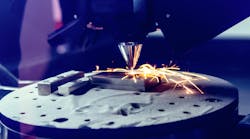Data-Driven 3D Printers: The Real Game-Changers for Manufacturing?
We're all familiar with photos of Ford’s production lines in 1920. Would we recognize them today? As part of the broader Industry 4.0 trend, systems in many factories have modernized considerably in recent years. This digitization of the manufacturing sector aims to apply emerging technologies — such as cloud computing, smart automation, IoT devices, digital inventories, and data analytics — to use data to help engineers make better decisions, improve factory processes, and ultimately require less human oversight.
At the center of the factory’s shift towards digital is additive manufacturing, which enables the core suite of Industry 4.0 technologies to be directly applied to the process of fabrication itself. 3D printers have come a long way from their humble beginnings as rapid prototyping machines and gimmick factories for novelty items. They’ve upleveled not just into machines that fabricate high-performance parts for factories to airplanes, but also into data collection hubs that gather massive quantities of information about how different parts are built during the fabrication process.
Similar to how autonomous vehicles collect and apply data to continuously improve the ability of the car to drive, connected 3D printers can use collected data for artificial intelligence-powered automation. During each print job, 3D printers produce large quantities of data that are sent to and stored in the cloud. The data can then be fed to algorithms, which printers and users can access through the cloud. Among other things, this data can help businesses make decisions about which parts to print and how best to print them, while improving the quality of print jobs.
AI in Additive
With the current state of manufacturing technology, AI can take a hardware problem and offer a software solution. Machine learning can optimize hardware, automatically enhancing 3D printers through software updates to increase printing speeds and improve resolution. AI can help businesses determine which parts, when produced in-house through additive manufacturing, will have the biggest impact on their bottom line. It can also connect to digital catalogs of existing parts and detect which specific parts are the best candidates to be printed through various additive manufacturing techniques.
With connectivity to cloud software, 3D printers can use machine learning to automatically generate tooling jigs or fixtures to hold the parts they print. Manufacturers with more mature AM proficiencies are applying AI-based optimizations during the design stage of new parts — simulating how the digital design for a part, once printed, will perform under specific loads. AI is also employed in additive manufacturing to detect print failures (proactively pausing prints when needed), and to inspect parts as they’re being printed to ensure quality and conformance.
A Closed Loop
The same hardware out in the field is consistently learning, improving and getting smarter with every over-the-air update. As providers advance the quality of information collected during fabrication and build modes of collecting data about how each 3D printed part does its job on the field, manufacturing technology approaches a fully automated “closed-loop” printing process: One that can simply be presented with a real-world manufacturing problem to solve, and then design and build the part using the specific digital fabrication technology that makes the most sense given the defined time, cost, and performance constraints.
This smart, closed-loop automation of fabrication can substantially increase outputs and production speeds. And while additive manufacturing inherently streamlines the process of building parts, each savvy application of data collected by the printers can streamline distinct points within the additive manufacturing process. Engineers can move away from manual tasks that are now automated — such as quality inspection and designing tooling or fixtures for parts — and focus on innovating and solving more interesting problems. Machinists can focus on fabricating the parts that either contribute the most business value, or can only be made through machining.
Changing Supply Chains
The biggest area for these data-driven 3D printers to make an impact? The global supply chains of manufacturers, where inability to swiftly address ongoing disruptions in an agile manner often creates barriers to success.
The complexity and all-around difficulty of procuring parts and materials results in countless delays, shortages, and soaring prices. It’s s a problem that’s avoidable with some proactive action, and the world is catching on. With the introduction of federal initiatives like the U.S. government’s Additive Manufacturing Forward program, global supply chains are increasingly turning to 3D printing for fast lead times which can be conveniently delivered at points of need.
However, the supply chain value of smarter 3D printers is still relatively understated. Smarter 3D printers are more precise and fail-proof, incorporating their closed-loop learnings to add another layer of insurance against hold ups and failures, augmenting human decision-making in the critical problem-solving stages and fully automating many manual processes.
As AI’s presence in 3D printing continues to evolve, workflows found in factories increasingly resemble the industry’s vision for fully automated manufacturing. Given how smart additive manufacturing is already repairing broken supply chains, imagine the impact of the smartest 3D printers, which are still yet to come. Fully automated part design, fabrication, and quality control has the potential to address many acute supply chain challenges, further abridge lead times and uncover part designs that solve challenging problems.
Additive manufacturing adoption continues to expand to address ongoing supply chain challenges; and alongside AM, Industry 4.0 technologies continue to push the boundaries of what 3D printers are capable of. Given the pace of AI adoption in other industries, It has taken too long to bring effective AI to manufacturing, thanks to a (false) dichotomy between innovation and risk reduction.
Julie Van Der Hoop is a software product manager at Markforged who partners with customers to help them scale in their adoption of additive manufacturing. After working with enterprise companies to transform their operations, Julie knows the business value of automation and integration. Julie holds a Ph.D. from MIT.




